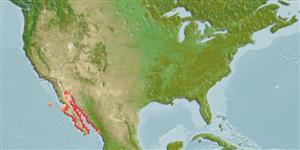Environment: milieu / climate zone / depth range / distribution range
Οικολογία
Θαλασσινό(ά) Υφαλόφιλο(α); εύρος βάθους 5 - 30 m (Ref. 9342). Subtropical; 33°N - 23°N, 119°W - 106°W (Ref. 5222)
Eastern Central Pacific: southern La Jolla, California, USA to Mazatlan, Mexico.
Μέγεθος / Βάρος / Age
Maturity: Lm ? range ? - ? cm
Max length : 198 cm TL αρσενικό/απροσδιόριστο; (Ref. 2850); μεγ. δημοσιευμένο βάρος: 91.0 kg (Ref. 5222)
Short description
Κλείδες προσδιορισμού | Μορφολογία | Μορφομετρία
Ραχιαίες άκανθες (συνολικά) : 11; Μαλακές ραχιαίες ακτίνες (συνολικά) : 16 - 17; Εδρικές άκανθες: 3; Μαλακές εδρικές ακτίνες: 10 - 11. Distinguished by the following characteristics: uniform dark brown or grey color of adults (can rapidly change into juvenile pattern when disturbed or under stress), large adults with white pectoral fin margin and median fins with narrow white edge; juvenile with greyish brown color, with dark spots along upper half of the body; depth of body 3.1-3.4 times in SL; head length 2.5-2.7 times in SL; rounded preopercle, finely serrate, lacking distinct lobe at the angle; posterior nostrils not notably enlarged, diameter less than twice of anterior nostrils (Ref. 89707).
Found in rocky reefs and kelp beds. Juveniles are unknown in California waters and the few large adults that have been taken there are probably expatriates from a more southerly breeding population. Large adults feed on fishes (Ref. 9342). Reported to prey on juvenile hammerhead sharks. Its large size makes it an object of game fishing (Ref. 9342).
Life cycle and mating behavior
Maturities | Αναπαραγωγή | Spawnings | Egg(s) | Fecundities | Προνύμφες
Heemstra, P.C. and J.E. Randall, 1993. FAO Species Catalogue. Vol. 16. Groupers of the world (family Serranidae, subfamily Epinephelinae). An annotated and illustrated catalogue of the grouper, rockcod, hind, coral grouper and lyretail species known to date. Rome: FAO. FAO Fish. Synop. 125(16):382 p. (Ref. 5222)
IUCN Red List Status (Ref. 130435)
Threat to humans
Harmless
Human uses
αλιεία: περιορισμένης εμπορικότητας; αλιεία αναψυχής: ναί
Εργαλεία
Special reports
Download XML
Διαδικτυακές πηγές
Estimates based on models
Preferred temperature (Ref.
123201): 18.6 - 25.9, mean 23 °C (based on 102 cells).
Phylogenetic diversity index (Ref.
82804): PD
50 = 0.5000 [Uniqueness, from 0.5 = low to 2.0 = high].
Bayesian length-weight: a=0.00933 (0.00429 - 0.02028), b=3.04 (2.87 - 3.21), in cm total length, based on LWR estimates for this Genus-body shape (Ref.
93245).
Τροφικό Επίπεδο (Ref.
69278): 4.5 ±0.80 se; based on food items.
Ελαστικότητα (Ref.
120179): Πολύ χαμηλό, ελάχιστος χρόνος για διπλασιασμό πληθυσμού > 14 έτη (Preliminary K or Fecundity.).
Fishing Vulnerability (Ref.
59153): Very high vulnerability (90 of 100).
Nutrients (Ref.
124155): Calcium = 8.75 [4.91, 18.12] mg/100g; Iron = 0.397 [0.198, 0.722] mg/100g; Protein = 19.5 [17.7, 21.3] %; Omega3 = 0.163 [0.086, 0.304] g/100g; Selenium = 19.6 [7.2, 42.9] μg/100g; VitaminA = 50.7 [13.8, 195.3] μg/100g; Zinc = 0.454 [0.295, 0.715] mg/100g (wet weight);
